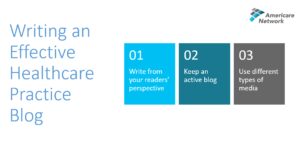Last week we focused on why and how you should start a blog. This time we are looking at some tips to writing an effective blog post.
What do we mean by “effective”?
Effective just means how much it helps your practice to reach your blogging goals. Like we said before, are you using the blog to drive traffic to your website? Or, are you using the blog as a way to communicate and engage more with current patients? What do you want your blog to do?
After you have figured this out and set up the website and blog itself, here are some ways you can go about creating exciting and effective content.
Write From Your Reader’s Perspective
Who do you want reading your blog? This plays into the goals of your blog. If you want to engage with current patients, what types of content do your current patients want to see? If you want to attract new patients, what do they want to read? Think of content that your readers or prospective readers will want to read about.
Consider you are writing for new and existing patients. The information that patients are interested in will be different than what physicians would like to read. Patients may not understand the same technical information that doctors do. So, in your blog posts you want to stay away from writing about your opinions on medical technology, for example. However, you still can post about medical advances but phrased in a way that patients would like to hear about it, such as celebrating the person who brought forth that advance in medicine or explaining to patients what it could mean for the everyday individual.
Or, for instance, you could use some blog posts to introduce new members of staff so your patients get to know them better. Another example may be using a blog post to celebrate a personal achievement by a member of your practice. You can even include achievements that are not profession related, such as, perhaps a staff member has completed a marathon over the weekend and you want to highlight this accomplishment (with their permission of course)! This way, it not only includes content that patients may be interested in, but it also creates a community and shows patients who the people are that help them in their healthcare practice, increasing trust and establishing a sense of community.
Post on a Regular Basis
Is your practice going to post weekly? Monthly? Daily? That last one might be difficult to accomplish but try to keep the blog posts updated in a routine manner. What this means is having and sticking to a posting schedule. Your practice may not have time to post weekly and that is alright. You may choose to post monthly and have one or two posts to update on important new information. You may also decide to add in a post or two in between scheduled blog posts for things like major holidays. Whichever way you choose, try to keep the posts consistent. An active blog or website can signal that there are actual people behind the website and that the healthcare practice is active itself.
Use Different Types of Media
Do not just post words. Most blogs have at least 1 image per post. Some may even have videos. It is important to have varying types of content in 1 post. This way, readers who are visual learners, for example, will have just a good experience on your website as someone who learns better through reading. A picture, diagram, or a video will help to tie all the text together and help convey your thoughts and the writing in a more effective way.
However, a photo is not just there to make the blog post look nice. There is another reason why you should insert images into your post. You can add what is known as “alt text” to a picture. This is the text description of the image that shows up when the image itself cannot be shown or the text that users with visual impairments hear if they use a text reading system. This can not only help the user’s experience, but the text also factors into what is known as SEO.
SEO
To understand why some of these tips are important to your blog, you must understand the concept of SEO. You may have heard it in passing, but what is it? In brief, SEO, or search engine optimization, is the practice of using non-paid (or “organic) methods to improve the quality of your website and the quantity of visitors to your site/blog.
Google search uses what are known as “key words” that users input into the search bar to find the best results that Google thinks the user wants to see. If your patients are finding your blog through a Google search, then it is very important to write from the patient’s perspective and use keywords in your writing that you think they will input into Google. For instance, someone may be looking for patient testimonials of your healthcare practice. They type in “[medical practice name] testimonials”. If you have this as a blog post or in some form of writing on your website, it could play into Google’s algorithm and show up as a search result. This is why it is important to write from the reader’s perspective.
Additionally, by updating the blog on a regular basis, you are adding more possible keywords for users to search for.
More importantly, when using keywords, images, or posting on a regular basis, make sure you are writing quality content that interest people. Create a simple blog that maximizes the user experience and attract readers. Furthermore, you can add some features on the blog that allow people to interact with and share the content you write, such as social media links.
Looking to get started? Take a look at last week’s blog post to learn how.
At Americare Network we specialize in medical billing. On top of this we have our unique financing service to provide even more support for your healthcare practice. We also offer practice transformation consulting and more to help your practice operate and grow. Contact us today to learn more about our services.





